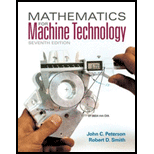
Mathematics for Machine Technology
7th Edition
ISBN: 9781133281450
Author: John C. Peterson, Robert D. Smith
Publisher: Cengage Learning
expand_more
expand_more
format_list_bulleted
Concept explainers
Question
Chapter 78, Problem 4AR
To determine
(a)
The angle
To determine
(b)
The angle
Expert Solution & Answer
Trending nowThis is a popular solution!

Students have asked these similar questions
4. Consider Chebychev's equation
(1 - x²)y" - xy + λy = 0
with boundary conditions y(-1) = 0 and y(1) = 0, where X is a constant.
(a) Show that Chebychev's equation can be expressed in Sturm-Liouville form
d
· (py') + qy + Ary = 0,
dx
y(1) = 0, y(-1) = 0,
where p(x) = (1 = x²) 1/2, q(x) = 0 and r(x) = (1 − x²)-1/2
(b) Show that the eigenfunctions of the Sturm-Liouville equation are extremals of the
functional A[y], where
A[y]
=
I[y]
J[y]'
and I[y] and [y] are defined by
-
I [y] = √, (my² — qy²) dx
and
J[y] = [[", ry² dx.
Explain briefly how to use this to obtain estimates of the smallest eigenvalue >1.
1
(c) Let k > be a parameter. Explain why the functions y(x) = (1-x²) are suitable
4
trial functions for estimating the smallest eigenvalue. Show that the value of A[y]
for these trial functions is
4k2
A[y] =
=
4k - 1'
and use this to estimate the smallest eigenvalue \1.
Hint:
L₁ x²(1 − ²)³¹ dr =
1
(1 - x²)³ dx
(ẞ > 0).
2ẞ
You recieve a case of fresh Michigan cherries that weighs 8.2 kg. You will be making cherry pies. Each pie will require 1 3/4 pounds of pitted cherries. How many pies can be made from the case if the yield percent for cherries is 87
Q/ show that the system:
x = Y + x(x² + y²)
y° =
=x+y (x² + y²)
9
X=-x(x²+ y²)
9 X
Y° = x - y (x² + y²)
have the same lin car part at (0,0) but they are topologically
different. Give the reason.
Chapter 78 Solutions
Mathematics for Machine Technology
Knowledge Booster
Learn more about
Need a deep-dive on the concept behind this application? Look no further. Learn more about this topic, advanced-math and related others by exploring similar questions and additional content below.Similar questions
- Q/ Find the region where ODES has no limit cycle: -X = X + X3 y=x+y+y'arrow_forwardB:Show that the function 4H(x,y)= (x² + y2)2-2((x² + y²) is a first integral of ODES: x=y + y(x² + y²) y=x+x (x² + y²) and sketch the stability of critical points and draw the phase portrait of system.arrow_forwardA: Show that the ODES has no limit cycle in a region D and find this region: x=y-2x³ y=x+y-2y3 Carrow_forward
- optımızatıon theoryarrow_forwardQ3)A: Given H(x,y)= x²-x4 + y² as a first integral of an ODEs, find this ODES corresponding to H(x,y) and show the phase portrait by using Hartman theorem and by drawing graph of H(x,y)=c. Discuss the stability of critical points of the corresponding ODEs.arrow_forwardSolve the given differential equation by using an appropriate substitution. The DE is homogeneous. y-x dy dx = y + xarrow_forward
- Q1: solve the system y 2 In √√x² + y2 X y = −y + In √√x² + y2 and solve the linear part.arrow_forwardFind all the solutions of the congruence 7x² + 15x = 4 (mod 111).arrow_forward) The set {1,2,..., 22} is to be split into two disjoint non-empty sets S and T in such a way that: (i) the product (mod 23) of any two elements of S lies in S; (ii) the product (mod 23) of any two elements of T lies in S; (iii) the product (mod 23) of any element of S and any element of T lies in T. Prove that the only solution is S = {1, 2, 3, 4, 6, 8, 9, 12, 13, 16, 18}, T= {5, 7, 10, 11, 14, 15, 17, 19, 20, 21, 22}.arrow_forward
arrow_back_ios
SEE MORE QUESTIONS
arrow_forward_ios
Recommended textbooks for you
 Mathematics For Machine TechnologyAdvanced MathISBN:9781337798310Author:Peterson, John.Publisher:Cengage Learning,
Mathematics For Machine TechnologyAdvanced MathISBN:9781337798310Author:Peterson, John.Publisher:Cengage Learning, Elementary Geometry for College StudentsGeometryISBN:9781285195698Author:Daniel C. Alexander, Geralyn M. KoeberleinPublisher:Cengage Learning
Elementary Geometry for College StudentsGeometryISBN:9781285195698Author:Daniel C. Alexander, Geralyn M. KoeberleinPublisher:Cengage Learning Elementary Geometry For College Students, 7eGeometryISBN:9781337614085Author:Alexander, Daniel C.; Koeberlein, Geralyn M.Publisher:Cengage,
Elementary Geometry For College Students, 7eGeometryISBN:9781337614085Author:Alexander, Daniel C.; Koeberlein, Geralyn M.Publisher:Cengage, Holt Mcdougal Larson Pre-algebra: Student Edition...AlgebraISBN:9780547587776Author:HOLT MCDOUGALPublisher:HOLT MCDOUGAL
Holt Mcdougal Larson Pre-algebra: Student Edition...AlgebraISBN:9780547587776Author:HOLT MCDOUGALPublisher:HOLT MCDOUGAL Trigonometry (MindTap Course List)TrigonometryISBN:9781337278461Author:Ron LarsonPublisher:Cengage Learning
Trigonometry (MindTap Course List)TrigonometryISBN:9781337278461Author:Ron LarsonPublisher:Cengage Learning

Mathematics For Machine Technology
Advanced Math
ISBN:9781337798310
Author:Peterson, John.
Publisher:Cengage Learning,

Elementary Geometry for College Students
Geometry
ISBN:9781285195698
Author:Daniel C. Alexander, Geralyn M. Koeberlein
Publisher:Cengage Learning

Elementary Geometry For College Students, 7e
Geometry
ISBN:9781337614085
Author:Alexander, Daniel C.; Koeberlein, Geralyn M.
Publisher:Cengage,

Holt Mcdougal Larson Pre-algebra: Student Edition...
Algebra
ISBN:9780547587776
Author:HOLT MCDOUGAL
Publisher:HOLT MCDOUGAL

Trigonometry (MindTap Course List)
Trigonometry
ISBN:9781337278461
Author:Ron Larson
Publisher:Cengage Learning

How to find the magnitude and direction of a given vector; Author: Brian McLogan;https://www.youtube.com/watch?v=4qE-ZrR_NxI;License: Standard YouTube License, CC-BY
Linear Algebra for Computer Scientists. 2. Magnitude of a Vector; Author: Computer Science;https://www.youtube.com/watch?v=ElnuSJyUdR4;License: Standard YouTube License, CC-BY